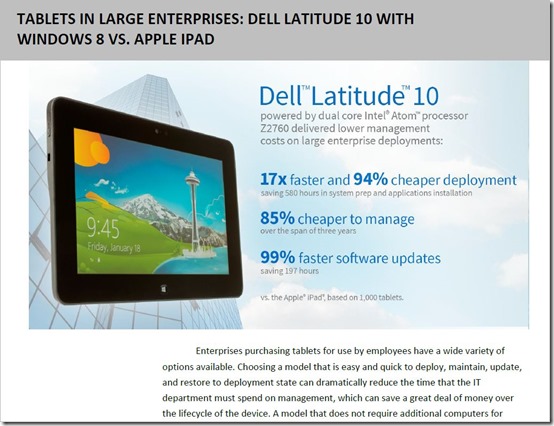Tablets are great. They’re light, portable, not too expensive, and packed with helpful, accessible applications. What was originally an amazing consumer device has also become a winner in the world of business. These are all instant reasons to get – or equip your workforce with – tablets.
But they’re just that – instant reasons. Not well thought–out, reasoned, planned decisions. After the first blush of tablet mania, we’re now at the point where it’s time for serious, planned adoption. There’s now a great deal more choice in terms of platforms out there, and plenty of approaches to managing them. This is where Dell Channel partners can really help their customers make the right decision for their business – a new wave of technology brings with it new complexities.
It’s also a point at which some of the shortcomings of the first iterations of tablets became apparent: The limited processing power. The complexity of printing from a tablet. Battery replacement. The lack of an office productivity software suite that’s compatible with most of your office computers. The availability of Mobile Device Management (MDM) software within IT organisations. The lost hours of support keeping a wide and varied collection of employee’s own tablets up to scratch. Then there is the issue of security, updates, whether these devices can use bespoke in-house software platforms and the like.
If the first tablet wave was about the user experience, the second is about effective management and support and productivity. We know they work, they’re useful and that users love them. But we need to prove that, in a corporate environment, they don’t become an expensive headache – and that they do things that provide good to the company buying and supporting them, rather than just the users.
We commissioned Principled Technologies to research the total cost of ownership of tablets – specifically, to compare the cost of managing a thousand Apple iPads and a thousand Dell Latitude 10 tablets over three years. A few highlights: Latitude 10 deployment is 17 times faster, and 94 percent cheaper to deploy, than the iPad. Printing is $5,000 cheaper, as the Latitude 10 doesn’t need printer workstations to print. Latitude 10’s battery replacement can be done in seconds on-site by a company’s desktop support staff – while iPads have to go back to Apple. If half of batteries require a replacement over the three years, that adds up to a lot of iPads going back to Apple – and not in the hands of staff in the meantime.
The iPad is a very popular gaming and media tablet – but it’s a consumer device in a business world and now it’s time for business tablets to get the job done efficiently and effectively. Dell Partners are in a particularly good position to help their customer roll out mobile devices that truly support their employees now and as their needs and requirements change.
To see more research findings, download the white paper Tablets in large enterprises: Dell Latitude 10 with Windows 8 vs. Apple iPad. Otherwise, click on the image below to view it:
Enjoy this post? To stay in touch with latest information and updates from Dell PartnerDirect in Europe, follow @DellChannelEN
